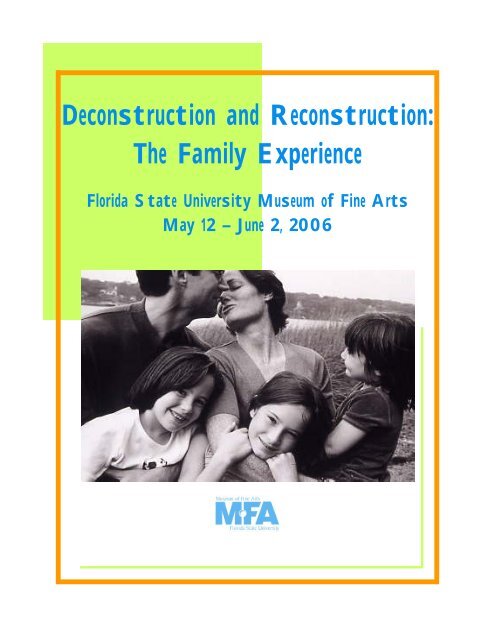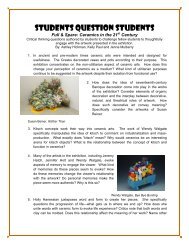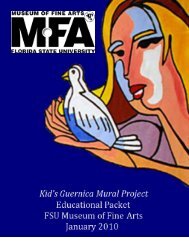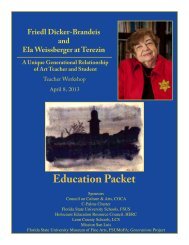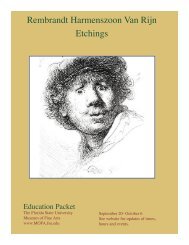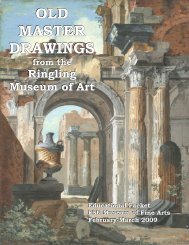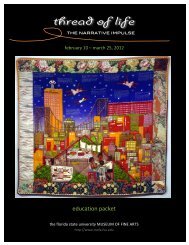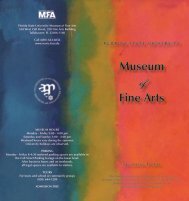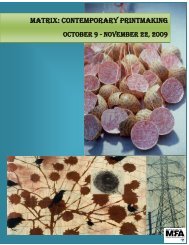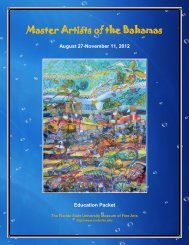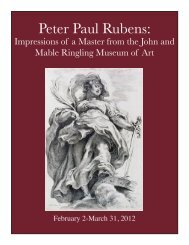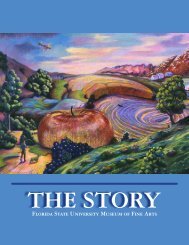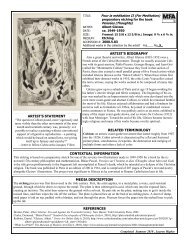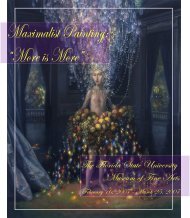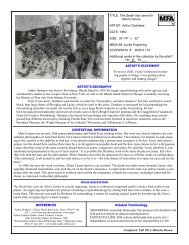Deconstruction and Reconstruction: The Family Experience
Deconstruction and Reconstruction: The Family Experience
Deconstruction and Reconstruction: The Family Experience
Create successful ePaper yourself
Turn your PDF publications into a flip-book with our unique Google optimized e-Paper software.
<strong>Deconstruction</strong> <strong>and</strong> <strong>Reconstruction</strong>:<br />
<strong>The</strong> <strong>Family</strong> <strong>Experience</strong><br />
Florida State University Museum of Fine Arts<br />
May 12 — June 2, 2006
<strong>Deconstruction</strong> <strong>and</strong> <strong>Reconstruction</strong>:<br />
<strong>The</strong> <strong>Family</strong> <strong>Experience</strong><br />
Florida State University Museum of Fine Arts<br />
May 12 - June 2, 2006<br />
An Educational Supplement to the Museum’s Exhibition<br />
Table of Contents<br />
Families: How <strong>The</strong>y Have Evolved .........................................................................2<br />
<strong>Family</strong> Depictions in Art Through History................................................................4<br />
<strong>Family</strong> Depictions in Art Through History: <strong>The</strong> Images ...........................................7<br />
Quotes on <strong>Family</strong>....................................................................................................11<br />
Artists: Sasha Bezzubov <strong>and</strong> Jessica Sucher.........................................................13<br />
Artist: Andrew Joseph Ortiz ....................................................................................15<br />
Artist: Laura Straus .................................................................................................17<br />
Artist: Chelsy Walker...............................................................................................19<br />
Lesson Plan 1: Photographing Families..................................................................21<br />
Lesson Plan 2: <strong>Family</strong> Tree ....................................................................................23<br />
Lesson Plan 3: Analysis Fun!..................................................................................25<br />
Vocabulary Sheet .............................................................................27<br />
Worksheet ........................................................................................28<br />
Lesson Plan 4: Families are Unique .......................................................................29<br />
Worksheet........................................................................................31<br />
Bibliography ............................................................................................................32<br />
Sunshine State St<strong>and</strong>ards ......................................................................................33<br />
Selected Image List ................................................................................................35<br />
Edited by Emilee Hubbard <strong>and</strong> Viki D. Thompson Wylder<br />
Graphic Design by Emilee Hubbard<br />
This educational packet was written by Emilee Hubbard under the direction of Viki D.<br />
Thompson Wylder, Curator of Education, Florida State University Museum of Fine Arts.<br />
Tours Available: Contact Viki D. Thompson Wylder at 644-1299<br />
Cover: Laura Straus, Mamaronech, NY: Rafferty <strong>Family</strong><br />
*Images for one-time educational use only.<br />
1
Kais, Jamal, <strong>and</strong> Malach, Palestinian Americans<br />
Charles Rushton<br />
Families: How <strong>The</strong>y Have Evolved<br />
<strong>The</strong> American family looks much different than it did in the time of television<br />
shows like Ozzie <strong>and</strong> Harriet. During the post-war years, when shows like this ran on<br />
the air, Americans celebrated the nuclear family. <strong>The</strong> nuclear family consists of a<br />
breadwinning dad, homemaker mom, <strong>and</strong> two to three children. <strong>The</strong> name “nuclear”<br />
was coined long after the concept of the nuclear family arose. <strong>The</strong> nuclear family was<br />
first conceived during the Middle Ages in Europe. Even though the idea of the nuclear<br />
family has existed for a long time, it rarely embodied the majority of families in human<br />
history. Many still seek this ideal today.<br />
If we take a snapshot of families in 1960 <strong>and</strong> 2000, we can see how different<br />
they are. After the world wars, America sought stability. <strong>The</strong> year 1960 marks the heart<br />
of this period. From the 1940s to the 1960s the nuclear family thrived. Through a look<br />
at statistics for the year 1960 <strong>and</strong> 2000, the differences<br />
in the American family are clear. <strong>The</strong> divorce rate<br />
doubled. In 1960, ¼ of all marriages ended in divorce.<br />
In 2000, that rate rose to ½. <strong>The</strong> percentage of single<br />
parent families with children under 18 went from 5% to<br />
13%. Only 5% of children were born to unmarried<br />
mothers in 1960; in 2000 the number jumped to 33%.<br />
<strong>The</strong> percentage of the marriageable population actually<br />
married dropped 15%. Americans are marrying later;<br />
the average age of women was 20 <strong>and</strong> men 23 in 1960.<br />
In 2000, the average age for women was 25 <strong>and</strong> for<br />
men, 27. <strong>The</strong> number of children in the family has<br />
decreased since 1960 from 2.3 kids to 1.9 per family.<br />
<strong>The</strong>se statistics can lead to a number of conclusions<br />
about the American family today <strong>and</strong> its future, but in<br />
general families are becoming more diverse <strong>and</strong> more<br />
realistic than idealistic.<br />
In the earliest days, humans approached the<br />
issue of family in practical fashion. Early humans “pair-bonded,” marriage-like, mainly<br />
to take care of their children. <strong>The</strong>y were grouped together through extended families for<br />
survival. Since the Middle Ages <strong>and</strong> the development of the idea of “<strong>The</strong> Holy <strong>Family</strong>,”<br />
society eventually developed one idealized goal, the nuclear family. This ideal has<br />
been sought even in times when it became impractical. <strong>The</strong> Commercial <strong>and</strong> Industrial<br />
Revolutions brought a new emphasis on education, especially of women. As time<br />
passed more women gradually achieved higher education <strong>and</strong> eventually more women<br />
were working outside the home. <strong>The</strong> emphasis on extended education for both sexes<br />
delayed marriage. <strong>The</strong> homemaker mom diminished during the world wars, particularly<br />
WWII, when a large number of women entered the workforce, the result of the absence<br />
of men. After WWII, there was a slight increase in divorce. Yet, after these years of<br />
women working outside the home <strong>and</strong> a rise in the divorce rate, the concept of the<br />
nuclear family was never stronger.<br />
2
After the 1960s the nuclear family was on the decline, <strong>and</strong> still is today. Yet,<br />
Americans remain nostalgic for the “good old days” when mom stayed at home <strong>and</strong> had<br />
dinner on the table when dad returned from work. <strong>The</strong> “good old days,” however,<br />
existed only during a very small fraction of historical time. Families rarely operated in<br />
nuclear fashion before the 1940s.<br />
When Americans finally reached that ideal of the nuclear family, why did it<br />
decline so rapidly? <strong>The</strong> number one reason centers on young mothers who tend to<br />
work outside the home. With the advent of educational <strong>and</strong> valuable career<br />
opportunities, women are starting families later <strong>and</strong> no longer looking for financial<br />
security as their major reason for marriage.<br />
Yet today women still do 2/3 of the housework <strong>and</strong> 4/5 of the childcare. <strong>The</strong> idea<br />
of the nuclear family has not been completely ab<strong>and</strong>oned. Although nostalgia for<br />
nuclear roles still exists, families on television<br />
shows have changed from Ozzie <strong>and</strong><br />
Harriet’s nuclear structure. Shows like<br />
Friends have numerous examples of modern<br />
families; divorced parents, same sex<br />
marriage, single parents, <strong>and</strong> adoption are all<br />
portrayed on the show. Yet, the cleaning<br />
product commercials on television still pitch<br />
to married women. What effect will come<br />
from this idealized nostalgia mixed with the<br />
realism of women working outside the home?<br />
Does the future hold a return to realism in<br />
family life or will we still seek the nuclear<br />
family?<br />
New directions in society are taking<br />
Eleanor at the Computer, Dad Watching<br />
Cathy Lees<br />
place. Society accepts, to varying degrees, single parents, foster parents, mixed race<br />
parents, same sex parents, disabled family members, <strong>and</strong> combination homes with one<br />
or both parents having children from previous marriages. Many couples will go to<br />
couples counseling now to try to reconcile before making the decision to divorce. As<br />
stated, one half of marriages are ending in divorce. However, the other half are making<br />
these new family situations work. Accommodations are being made for young children<br />
of working moms. We have daycares, after school care, stay-at-home dads, <strong>and</strong><br />
opportunities to work at home <strong>and</strong> make money. It seems as though Americans today,<br />
with all the accommodations being made, are heading toward a more realistic view of<br />
the family.<br />
3
Depictions of <strong>Family</strong> Through Art History<br />
<strong>The</strong> portrayal of family arises throughout the history of art. Styles vary<br />
<strong>and</strong> themes differ, but as is natural for the human race, the family is always<br />
present. In some epochs, family is a main theme <strong>and</strong> in other periods it is not as<br />
prevalent yet still exists. Some major types of family representations emerge.<br />
<strong>The</strong>y are the Marriage Portrait, Artists’ Families, the Symbolic <strong>Family</strong>, the<br />
Everyday <strong>Family</strong>, <strong>and</strong> the Noble <strong>Family</strong>. We will explore the different themes in<br />
which family has been depicted through the history of primarily Western art.<br />
<strong>The</strong> Marriage Portrait was one of the earliest of “family in art” types to be<br />
formulated. Affectionate couples appeared surprisingly early. However, the<br />
marriage portrait was not moved out of tombs <strong>and</strong> into the home until the 1 st<br />
century BCE. Marriage portraits placed in the<br />
home from this time are equivalent to modern<br />
wedding portraits, reminiscent of the modern<br />
couple commissioning a portrait to celebrate<br />
their marriage. Depending on the era, the<br />
celebratory wedding portrait was executed in<br />
the contemporary style in which it was<br />
commissioned <strong>and</strong> portrayed the contemporary<br />
marriage culture. Sometimes the artists chose<br />
to show their contemporary marriage culture as<br />
negative as in William Hogarth’s series,<br />
Marriage a la Mode. However, the overall<br />
Doll <strong>Family</strong> Sculptures<br />
Pat Magers<br />
Frances (Engl<strong>and</strong>), Lek, Nick – Thail<strong>and</strong><br />
Sasha Bezzubov <strong>and</strong> Jessica Sucher<br />
2003<br />
theme of marriage portraits was an increasing emphasis on a realistic vision of<br />
the couple.<br />
Artists also chose to represent family in their artworks by featuring a<br />
Symbolic <strong>Family</strong>. This Symbolic <strong>Family</strong> portrait generally included Mary, Joseph,<br />
<strong>and</strong> Jesus from the Christian religion or the<br />
Roman <strong>and</strong> Greek gods from mythological<br />
stories. <strong>The</strong>se Symbolic <strong>Family</strong> images were<br />
widespread throughout art history. <strong>The</strong> era that<br />
favored the Holy <strong>Family</strong> was the Italian<br />
Renaissance, yet its frequent portrayal occurred<br />
long before as a staple in the Middle Ages. <strong>The</strong><br />
many “Virgin <strong>and</strong> Child” paintings, nativity scenes,<br />
<strong>and</strong> pietas represent the love between parent <strong>and</strong><br />
child. <strong>The</strong> Italian Renaissance painters also<br />
depicted Roman gods who represented certain<br />
attributes of family.<br />
<strong>The</strong>se family works, whether Christian or mythological, sometimes<br />
bestowed importance to extended family. Many Christian paintings of the Holy<br />
<strong>Family</strong> include cousins <strong>and</strong> aunts. For example, Leonardo da Vinci’s cartoon<br />
drawing, Virgin <strong>and</strong> Child with Saint Anne <strong>and</strong> Infant Saint John shows Jesus’<br />
gr<strong>and</strong>mother <strong>and</strong> second cousin. Mythological works of Roman <strong>and</strong> Greek gods<br />
4
often show various figures in family roles <strong>and</strong> relationships as in Titian’s painting<br />
of a potential husb<strong>and</strong> <strong>and</strong> wife, Bacchus <strong>and</strong> Adriadne.<br />
Artists sometimes portray family by depicting their own families. In the<br />
Italian Renaissance the few women artists during the era had limited access to<br />
models. Sometimes a woman artist chose to paint her most accessible subject,<br />
her own family. For example, Sofonisba Anguissola painted Portrait of the<br />
Artist’s Sisters <strong>and</strong> Brother. This is not exclusive to women artists of the Italian<br />
Renaissance. Women artists did this<br />
throughout art history <strong>and</strong> many men worked in<br />
this tradition as well. In the Rococo era,<br />
François Boucher used his family as models in<br />
his painting titled <strong>The</strong> Luncheon. Artists may<br />
find their families as unique entities. <strong>The</strong><br />
access to the family makes it an easy subject to<br />
use.<br />
In the early eighteenth century, artists<br />
occasionally painted their own families to show<br />
the wealth of the family <strong>and</strong> to highlight fond<br />
<strong>Family</strong> Rituals: Discount Store #4<br />
Severn Eaton<br />
Untitled #1<br />
Laine Wyatt<br />
interaction between children <strong>and</strong> elders. Women artists, with the ability to carry a<br />
child, sometimes chose to portray their maternal attributes in their works.<br />
Elisabeth Vigée-Lebrun’s painting, Self-Portrait with Her Daughter, emphasizes<br />
this attribute.<br />
Other artists painted family members who resided far away geographically<br />
or members that were deceased. <strong>The</strong> artists’ longing for the missing family<br />
members was usually the reason behind the subject choice. For example,<br />
Arshille Gorky painted <strong>The</strong> Artist <strong>and</strong> His Mother several years after her death.<br />
<strong>The</strong> artists who chose to portray their own families did so for many<br />
reasons. As stated, one incentive was the family’s ready availability, especially<br />
for early women artists. Another reason was the desire to honor the family <strong>and</strong><br />
its influence. Families acculturate or “frame” the people within them. <strong>The</strong>se<br />
artists, in turn, literally reversed the framing by placing family within the confines<br />
of their canvases. By putting their families into their works, these artists revealed<br />
a bit of their own personalities through the people closest to them or at least<br />
revealed those traits they wanted the public to see.<br />
An extension of the Artists’ <strong>Family</strong> Portrait<br />
was the portrayal of the Everyday <strong>Family</strong>. Some<br />
artists chose to show what we see everyday in<br />
our own family lives <strong>and</strong> in other families around<br />
us. Dependent on the time period in which it<br />
was painted the Everyday <strong>Family</strong> Portrait<br />
emphasized one family member or the other. In<br />
the first half of the eighteenth century the<br />
importance of the mother’s role in the family was<br />
emphasized. An example of this is the painting<br />
by Jean-Baptiste-Siméon Chardin titled Mother’s<br />
Advice. In the second half of that century, the<br />
5
father became central to the family. This can be seen in the painting titled <strong>The</strong><br />
Village Bride by Jean-Baptiste Greuze. Despite the title, the father figure is<br />
placed at the center of the canvas with his family extending compositionally to<br />
the left <strong>and</strong> the right. At the end of the nineteenth century, importance centered<br />
on the child in the artwork. For example, Félix Vallottan painted Dinner by<br />
Lamplight in which the child is centralized <strong>and</strong> becomes the focal point.<br />
As in the Marriage Portrait, Everyday Families were not always depicted in<br />
a celebratory way. Some artists chose to portray problems in common families.<br />
Some chose to depict everyday families in a didactic manner hoping to influence<br />
society by visual example. An artist who did this was Jan Steen as in his<br />
painting, <strong>The</strong> Dissolute Household.<br />
<strong>The</strong> artists who chose to represent the Everyday<br />
<strong>Family</strong> did so in the styles of their own epochs. <strong>The</strong> artists<br />
placed emphasis on what they saw as important <strong>and</strong> what<br />
their society deemed as important in family life.<br />
In opposition to the Everyday <strong>Family</strong> other artists<br />
chose to portray the Noble <strong>Family</strong> life. <strong>The</strong> Noble <strong>Family</strong><br />
consisted of royalty, aristocrats, gentry, <strong>and</strong> so on.<br />
Royalty had, for a long time, commissioned likenesses of<br />
themselves <strong>and</strong> their families. <strong>The</strong>re are hundreds of<br />
models of these. Some of these artworks included<br />
religious scenes. <strong>The</strong> noble family wanted renditions of<br />
themselves witnessing the scene within the painting. An<br />
example of this is the painting Madonna of the Pesaro<br />
<strong>Family</strong> by Titian. Artwork containing representations of<br />
Mother <strong>and</strong> Daughter<br />
Janet McKenzie<br />
royal families can even be found in the Egyptian pyramids. Royal <strong>and</strong> noble<br />
families still commission artists in a similar fashion today.<br />
Depictions of family retain their importance in our own time, though new<br />
sub-genres may be developing. Images in this section are indicative. Illustrated<br />
works like Severn Eaton’s <strong>Family</strong> Rituals: Discount Store #4 or Laine Wyatt’s<br />
Untitled #1 fall into such historical categories as the Everyday <strong>Family</strong>. Pat<br />
Mager’s Doll <strong>Family</strong> Sculptures bear a resemblance to the Symbolic <strong>Family</strong><br />
category. Works like those by Bezzubov, Sucher, <strong>and</strong> McKenzie strike new<br />
notes in family representation. Bezzubov <strong>and</strong> Sucher show an English mother<br />
<strong>and</strong> a Thai father with their mixed race son. McKenzie’s Mother <strong>and</strong> Daughter<br />
image shows a mother of color with a blond-haired child. Both these works,<br />
suggestive of the global society of today, point to the emergence of artwork<br />
emphasizing the multicultural composition of many contemporary families. <strong>The</strong><br />
Multicultural <strong>Family</strong>, <strong>and</strong> other new sub-genres, may be joining those found<br />
traditionally in art history.<br />
<strong>The</strong> existence of sub-genres of the family portrait testifies to the popularity<br />
<strong>and</strong> significance of the family theme art historically. <strong>The</strong>se various sub-genres,<br />
the Noble <strong>Family</strong>, the Everyday <strong>Family</strong>, the Symbolic <strong>Family</strong>, Artists’ Families,<br />
the Marriage Portrait, as well as those developing today, all reflect the art style<br />
contemporaneous to their making, but more importantly they reflect western<br />
culture’s view of family’s place, function, <strong>and</strong> intricacies over time.<br />
6
<strong>Family</strong> Depictions in Art through History<br />
<strong>The</strong> Images<br />
Raherka <strong>and</strong> Merseankh,<br />
Husb<strong>and</strong> <strong>and</strong> Wife<br />
c. 2500-2350 BCE<br />
Egyptain<br />
A painted<br />
limestone statue<br />
found in a tomb<br />
shows a wedded<br />
couple embracing<br />
affectionately.<br />
Pompeii<br />
c. 70-69 CE<br />
<strong>The</strong> Marriage Portrait<br />
<strong>The</strong> marriage<br />
portrait is placed<br />
in the home. This<br />
portrait is painted<br />
on the wall, <strong>and</strong> is<br />
equivalent to the<br />
modern day<br />
celebratory<br />
wedding portrait.<br />
Marriage of Giovanni Arnolfini<br />
<strong>and</strong> Giovanna Cenami<br />
1434<br />
Jan van Eyck<br />
This painting is a<br />
typical celebratory<br />
marriage portrait done<br />
in a naturalistic style of<br />
the time it was<br />
comssioned.<br />
Sarcophagus of the Wedded Couple<br />
Late 6 th century BCE<br />
Etruscan<br />
This piece, made of<br />
terracotta, shows another<br />
affectionate couple in a<br />
conversation or<br />
interaction of some sort.<br />
<strong>The</strong>se affectionate<br />
couples are surprising in<br />
early art.<br />
From series Marriage a la Mode<br />
1744<br />
William Hogarth<br />
In this series, Hogarth<br />
paints the failing of a<br />
marriage. <strong>The</strong>se<br />
paintings give a negative<br />
portrayal of the marriage<br />
<strong>and</strong> family culture of<br />
Hogarth’s contemporaries.<br />
7
Virgin <strong>and</strong> Child with<br />
Saint Anne <strong>and</strong> the<br />
Infant Saint John<br />
Leonardo da Vinci<br />
Virgin <strong>and</strong> Child with Saint<br />
Anne <strong>and</strong> a lamb<br />
c. 1510<br />
Leonardo da Vinci<br />
Portrait of the Artist’s<br />
Sisters <strong>and</strong> Brother<br />
1555<br />
Sofonisba Anguissola<br />
This female artist<br />
regularly painted<br />
her family because<br />
during this time it<br />
was her most<br />
accessible subject.<br />
Self-Portrait with Her Daughter<br />
1786<br />
Elisabeth Vigée-Lebrun<br />
<strong>The</strong> artist portrays<br />
herself <strong>and</strong> her<br />
daughter to<br />
emphasize her<br />
own maternity,<br />
her own ability to<br />
produce family.<br />
<strong>The</strong> Symbolic <strong>Family</strong><br />
<strong>The</strong>se images show<br />
gr<strong>and</strong>mother,<br />
mother, child,<br />
gr<strong>and</strong>child, second<br />
cousin, <strong>and</strong> greataunt<br />
relations.<br />
<strong>The</strong>se relationships<br />
are seen though the<br />
portrayals of Mary,<br />
Saint Anne, Saint<br />
John the Baptiste,<br />
<strong>and</strong> Jesus.<br />
Artists’ Families<br />
<strong>The</strong> Luncheon<br />
1739<br />
François Boucher<br />
Bacchus <strong>and</strong> Adriadne<br />
1520<br />
Titian<br />
<strong>The</strong> Roman god<br />
Bacchus shows his<br />
love for the<br />
returning Adriadne<br />
in a proposal for<br />
marriage.<br />
This painting shows<br />
the fashionable<br />
interior, the wealth,<br />
<strong>and</strong> the fond<br />
interactions between<br />
the children <strong>and</strong><br />
elders in the Boucher<br />
family.<br />
<strong>The</strong> Artist <strong>and</strong> His Mother<br />
1926-1936<br />
Arshille Gorky<br />
This painting shows<br />
the artist’s longing<br />
for his mother who<br />
died several years<br />
before he painted<br />
this work.<br />
8
S<br />
Gaul <strong>and</strong> his Wife<br />
225 CE<br />
Hellenistic<br />
It was traditional<br />
for a Gaul male to<br />
take his wife <strong>and</strong><br />
children with him<br />
to battle<br />
campaigns. <strong>The</strong>se<br />
soldiers took what<br />
was important to<br />
them.<br />
<strong>The</strong> Everyday <strong>Family</strong><br />
Peasant Wedding Feast<br />
1567<br />
Pieter Brughel the Elder<br />
<strong>The</strong> Northern<br />
Renaissance artists<br />
produced many scenes<br />
of common family life<br />
like this one.<br />
<strong>The</strong> Dissolute Household<br />
c. 1668<br />
Jan Steen<br />
This didactic painting<br />
shows how laziness<br />
among other things<br />
can lead to chaos<br />
within a household.<br />
<strong>The</strong> Villiage Bride<br />
1761<br />
Jean-Baptiste Greuze<br />
Greuze shows the<br />
father as central to<br />
the family in this<br />
painting.<br />
Squirt<br />
1982<br />
Eric Fischl<br />
Fischl represents<br />
middle class America in<br />
many of his works.<br />
This painting shows the<br />
misbehaving boy <strong>and</strong><br />
the general events in<br />
which the middle class<br />
takes part.<br />
January from <strong>The</strong> Book of Hours<br />
Early 15 th century<br />
<strong>The</strong> Limborg Brothers<br />
Many of the<br />
medieval illustrations<br />
in the book are<br />
concerned with<br />
family focusing on<br />
courtship rituals <strong>and</strong><br />
community activities.<br />
A Mother Beside a Cradle<br />
c. 1659<br />
Pieter de Hooch<br />
This painting is not<br />
celebrating common<br />
family life.<br />
Rather,the artist is<br />
showing a mother,<br />
distant both<br />
physically <strong>and</strong><br />
emotionally, from<br />
her child.<br />
Mother’s Advice<br />
1738<br />
Jean-Baptiste-Siméon Chardin<br />
This painting gives<br />
importance to the<br />
mother’s role in<br />
the family<br />
emphasized in the<br />
contemporary<br />
society of the<br />
time.<br />
Dinner by Lamplight<br />
1899<br />
Félix Vallottan<br />
Along with his<br />
contemporaries,<br />
Vallottan gives<br />
importance to<br />
the child.<br />
9
Madoona of the Pesaro <strong>Family</strong><br />
1519-1526<br />
Titian<br />
Titian portrays a<br />
religious scene with the<br />
patron <strong>and</strong> his family<br />
looking onto the event.<br />
<strong>The</strong> family, as painted,<br />
only shows males. <strong>The</strong><br />
Pesaro family did not<br />
consist of only males,<br />
but the female<br />
members were not<br />
valued enough to be<br />
painted.<br />
<strong>The</strong> Noble <strong>Family</strong><br />
Las Meninas<br />
1656<br />
Diego Velásquez<br />
This is a scene<br />
of rich patrons<br />
looking on to<br />
their young<br />
daughter having<br />
her portrait<br />
painted.<br />
10
Quotes on <strong>Family</strong><br />
“Friend of my bosom, thou more than a brother,<br />
Why wert not thou born in my father’s dwelling?”<br />
- Charles Lamb<br />
“Nobody’s family can hang out the sign, ‘Nothing the matter here.’”<br />
- Chinese Proverb<br />
“<strong>Family</strong> jokes, though rightly cursed by strangers, are the bond that keeps most<br />
families alive.”<br />
- Stella Benson<br />
“Home is where the heart is.”<br />
- Pliny the Elder<br />
“<strong>The</strong> family. We were a strange little b<strong>and</strong> of characters trudging through life<br />
sharing diseases <strong>and</strong> toothpaste, coveting one another’s desserts, hiding<br />
shampoo, borrowing money, locking each other out of our rooms, inflicting pain<br />
<strong>and</strong> kissing to heal it in the same instant, loving, laughing, defending, <strong>and</strong> trying<br />
to figure out the common thread that bound us all together.”<br />
- Erma Bombeck<br />
“All happy families resemble one another; every unhappy family is unhappy in its<br />
own fashion.”<br />
- Leo Tolstoy<br />
“<strong>The</strong> happiest moments of my life have been the few which I have passed at the<br />
home in the bosom of my family.”<br />
- Thomas Jefferson<br />
“I hate to be a failure. I hate <strong>and</strong> regret the failure of my marriages. I would<br />
gladly give all my millions for just one lasting marital success.”<br />
- J. Paul Getty<br />
“Although today there are many trial marriages…there is no such thing as a trial<br />
child.”<br />
- Gail Sheehy<br />
“As the family goes, so goes the nation <strong>and</strong> so goes the world in which we live.”<br />
- Pope John Paul II<br />
“<strong>The</strong> family is one of nature’s masterpieces.”<br />
- George Santayana<br />
11
“<strong>The</strong> family is a place where principles are hammered <strong>and</strong> honed on the anvil of<br />
everyday living.”<br />
- Charles Swindoll<br />
“Without a family, man, alone in the world, trembles with the cold.”<br />
- Andre Maurois<br />
“<strong>The</strong> family is the nucleus of civilization.”<br />
- Will Durant<br />
“No one knows a son better than the father.”<br />
- Chinese Proverb<br />
“If you ever start feeling like you have the goofiest, craziest, most dysfunctional<br />
family in the world, all you have to do is go to a state fair. Because five minutes<br />
at the fair, you’ll be going, ‘you know, we’re alright. We are dang near royalty.”<br />
- Jeff Foxworthy<br />
“Relations are simply a tedious pack of people, who haven’t got the remotest<br />
knowledge of how to live, nor the smallest instinct about when to die.”<br />
- Oscar Wilde<br />
“<strong>The</strong> family is the test of freedom; because the family is the only thing that the<br />
free man makes for himself <strong>and</strong> by himself.”<br />
- Gilbert Keith Chesterton<br />
“It is not flesh <strong>and</strong> blood but the heart which makes us fathers <strong>and</strong> sons.”<br />
- Johan Schiller<br />
“<strong>Family</strong> isn’t about whose blood you have. It’s about who you care about.”<br />
- Trey Parker <strong>and</strong> Matt Stone<br />
12
Artists: Sasha Bezzubov <strong>and</strong> Jessica Sucher<br />
Thai <strong>Family</strong><br />
2002<br />
Sasha Bezzubov <strong>and</strong> Jessica Sucher<br />
Sasha Bezzubov <strong>and</strong> Jessica Sucher started their series, Families, after<br />
coming across a phenomenon in Costa Rica. <strong>The</strong>y encountered a German<br />
environmentalist in Costa Rica married to a native. <strong>The</strong>y soon discovered this is<br />
not rare. <strong>The</strong> two photographers traveled through Costa Rica, Nicaragua,<br />
Thail<strong>and</strong>, <strong>and</strong> Cambodia to find Westerners, mainly men, moving to these<br />
developing countries to marry natives. <strong>The</strong> Westerners hailed primarily from<br />
homel<strong>and</strong>s in Europe <strong>and</strong> North America. <strong>The</strong>se people wanted to marry into<br />
paradise.<br />
This phenomenon quickly found its way into Bezzubov <strong>and</strong> Sucher’s<br />
photography. <strong>The</strong>y posed the couples for the camera, yet not in a formal<br />
manner. <strong>The</strong> couples are sometimes accompanied by their children. Behind the<br />
figures, the backgrounds show the paradise-like l<strong>and</strong>scapes the Westerners<br />
desired. Bezzubov <strong>and</strong> Sucher photograph in color to enhance the l<strong>and</strong>scapes<br />
as well as the varying ethnicities of the families.<br />
13
Although paradise is in the background, the expressions on the faces of<br />
the families do not suggest they are living a utopian lifestyle. None of the family<br />
members in the photographs smile; rather they look quite solemn. Each of the<br />
figures st<strong>and</strong> next to each other, yet no connections nor loving interactions are<br />
photographed.<br />
Bezzubov <strong>and</strong> Sucher comment on the native aspirations that become<br />
part of these family relationships. <strong>The</strong> native half in each marriage carries as<br />
many, yet different, hopes <strong>and</strong> dreams as the Western half. <strong>The</strong> native family<br />
members have fancied illusions of money <strong>and</strong> security symbolized by marrying a<br />
Westerner. Yet these Westerners may no longer comm<strong>and</strong> the same earning<br />
power. <strong>The</strong>y have left their jobs in Europe <strong>and</strong> North America <strong>and</strong> have a new<br />
source of income based on the new homel<strong>and</strong> economy. <strong>Family</strong> finance issues<br />
arise for many of these couples. Bezzubov <strong>and</strong> Sucher say, “Perhaps the same<br />
frustrations they left in the West” arise in their new homes. <strong>The</strong> Westerners<br />
dreams of paradise break down when local politics <strong>and</strong> customs make divisions<br />
in their marriages. <strong>The</strong> idealistic goals are not fulfilled, but the families still exist<br />
<strong>and</strong> endure.<br />
Wesley <strong>and</strong> Maria<br />
Sasha Bezzubov <strong>and</strong> Jessica Sucher<br />
Yuri, Surayoum, Carsten (Germany), - Costa Rica<br />
2002<br />
Sasha Bezzubov <strong>and</strong> Jessica Sucher<br />
14
Artist: Andrew Joseph Ortiz<br />
<strong>Family</strong> Structure 4<br />
1995<br />
Andrew Joseph Ortiz<br />
Andrew Joseph Ortiz was born in Los Angeles to Mexican immigrants.<br />
Yet, because he was born <strong>and</strong> raised in the U.S. he feels an inconsistency<br />
between his lineages. In his artwork, he <strong>and</strong> his Spanish-speaking parents are<br />
often shown in conflict. Ortiz does not speak the same language as his parents.<br />
Cultural conflict erupts within his family <strong>and</strong> undermines his sense of self. <strong>The</strong><br />
identity clash Ortiz includes in his artwork carries meaning for all people who<br />
have such issues within their families <strong>and</strong> society.<br />
Ortiz moved to Texas in 1997. This move energized his curiosity about<br />
his heritage <strong>and</strong> his own cultural identity. He started a series in 1999 titled,<br />
Disconnection/Reconnection. In this series Ortiz “visually explores <strong>and</strong><br />
comments on feelings of cultural alienation <strong>and</strong>…attempt[s] to ‘reconnect’ with<br />
his heritage.” This issue continues to appear <strong>and</strong> evolve in Ortiz’s work.<br />
Ortiz’s art relates not only to an audience raised in the U.S. by parents of<br />
a foreign heritage, but his work transcends cultural boundaries. His works are<br />
understood by all people who deal with miscommunication within their families.<br />
15
<strong>The</strong> miscommunication, as Ortiz describes it, is “both literal…<strong>and</strong> on an<br />
emotional level.” Ortiz includes text in his pieces to clarify the story line centered<br />
on his family’s disconnection <strong>and</strong> his place within his family.<br />
Andrew Joseph Ortiz’s series in the <strong>Family</strong> <strong>Experience</strong> is titled Mi Familia:<br />
Words Unspoken, Words Unheard. <strong>The</strong> title itself emphasizes the separation<br />
created by language. Part of the title utilizes Spanish words <strong>and</strong> part of the title<br />
is written in English. Each piece in this series is a scanned collage of<br />
photographs <strong>and</strong> objects to create unique images of sometimes jumbled <strong>and</strong><br />
other times uncluttered scenes. Ortiz h<strong>and</strong>writes text on the bottom of each<br />
piece. <strong>The</strong> series is fearless in its revelation of the artist’s personal family life<br />
from his childhood to present. Ortiz creates work based on his family, but he<br />
surmounts simply personal expression by making the work symbolic for<br />
situations in many families.<br />
Stretching Line<br />
1995<br />
Andrew Joseph Ortiz<br />
16
Birmingham, Alabama: Nadine <strong>and</strong> Frank<br />
Laura Straus<br />
Artist: Laura Straus<br />
Laura Straus began her career as a photographer after years spent in<br />
photo editing. As an editor she worked closely with the works of photographers<br />
such as Cartier-Bresson, Sebastiao Salgado, <strong>and</strong> Eugene Richards. <strong>The</strong><br />
photography of these artists became key influences in her own work. Her<br />
photography style is that of the photo essay. Her subject matter deals mainly<br />
with family <strong>and</strong> relationships.<br />
Laura Straus’s photography of families takes on the various cultures <strong>and</strong><br />
classes of American society. In 2002, Straus started working in <strong>The</strong> Fields<br />
Project, in which she documented the lives of a four-generation farming family in<br />
Oregon, Illinois. She also documented a Mexican-American family in Texas for a<br />
small project. Laura Straus says her goal is to “live with twelve families in<br />
America – from the Northeast <strong>and</strong> South to Midwest, North, <strong>and</strong> Southwest.”<br />
Her American family photography is usually focused on children. Some works<br />
take on the family through the children’s eyes, while others show interactions<br />
within the relationships between parents <strong>and</strong> children. She explains, “<strong>Family</strong> is<br />
the first love that we live in <strong>and</strong> see through – it is the primary source from which<br />
all our other relationships <strong>and</strong> ways of seeing the world are formed. Watching<br />
families interact, with an emphasis on children, has become a powerful tool for<br />
exploring my many questions about the way we love.”<br />
17
Love is as present in her photography as the families themselves. Her<br />
photo essay style shows each family’s unique bond <strong>and</strong> the way in which they<br />
survive as a loving unit.<br />
Mamaronech, NY: Rafferty <strong>Family</strong><br />
Laura Straus<br />
Greene <strong>Family</strong><br />
Laura Straus<br />
18
Seeds of <strong>Family</strong><br />
Chelsy Walker<br />
Artist: Chelsy Walker<br />
Chelsy Walker began her work on family due to a persistent need to learn<br />
about her ancestors. She went through numerous microfilms to catch a glimpse<br />
of someone related to her. Walker believes, “we are all a product of the<br />
traditions of our fore[parents].” She searched for her own identity <strong>and</strong> that of her<br />
immediate family. Records such as census records, death records, cemetery<br />
listings, or obituaries may seem trivial in the search for identity, but to Chelsy<br />
Walker they mean everything. She says she relates the records she finds to an<br />
“’I was here’ scribbled on the wall <strong>and</strong> then dated; a proof of presence, of being.”<br />
Walker also seeks to find some sort of synopsis of each ancestor’s life. This<br />
biographical aspect of archived records is, as she says, “so inadequate, so<br />
indescript, a mere passing of a windblown seed, planted in my mind, yet without<br />
form or face.”<br />
<strong>The</strong>se ideas led Chelsy Walker to make Seeds of the <strong>Family</strong>. In this<br />
installation she links her family’s past to the present. Each seed represents one<br />
of her ancestors. Walker explains this piece by saying, “the parachute-type windcatching<br />
part of the seed is made up of all the records that I have found for one<br />
particular individual.” Each whole seed of the installation is slightly different,<br />
representing the unique ancestor or family member. Together these seeds,<br />
19
these individuals, make a whole, a family. She reminds viewers of the human<br />
origins of her work by having a resin-cast foot act as the actual seedling.<br />
Detail<br />
Seeds of <strong>Family</strong><br />
Chelsy Walker<br />
Detail<br />
Seeds of <strong>Family</strong><br />
Chelsy Walker<br />
20
Lesson Plan 1<br />
Photographing Families<br />
Session Activity: Students will be introduced to artwork by Sasha Bezzubov,<br />
Jessica Sucher, Anya E. Liftig, Robin Radin, Charles Rushton, Laura Straus, <strong>and</strong><br />
M. Laine Wyatt. Students will participate in an activity that will require them to<br />
photograph their families <strong>and</strong> then aesthetically judge their own work.<br />
Levels: 3-12<br />
Key Concepts/Objectives:<br />
1) <strong>The</strong> students will become familiar with the artwork of family photographers<br />
through analysis <strong>and</strong> discussion of their work.<br />
2) <strong>The</strong> students will create art from scenes of their own families.<br />
3) <strong>The</strong> students will learn to evaluate their own artwork.<br />
Materials:<br />
1) CD-Rom<br />
2) Computer/Projector<br />
3) Cameras<br />
Vocabulary:<br />
1) Pose<br />
Procedure:<br />
1) Explain to students how families have evolved since the 1960’s. Review<br />
the section titled “Families: How <strong>The</strong>y Have Evolved.”<br />
2) Follow up with images of family photography (all images can be found on<br />
the CD at the end of the packet):<br />
• Sasha Bezzubov <strong>and</strong> Jessica Sucher, Frances (Engl<strong>and</strong>), Lek, Nick<br />
– Thail<strong>and</strong>, 2003<br />
• Anya E. Liftig, Untitled #1<br />
• Robin Radin, July Fourth<br />
• Charles Rushton, Kais, Jamal, <strong>and</strong> Malach, Palestinian Americans<br />
• Laura Straus, Greene <strong>Family</strong><br />
• M. Laine Wyatt, Untitled #1 <strong>and</strong> Untitled #6<br />
3) For each image ask the following questions:<br />
• Describe what you see in the photograph.<br />
• How are the people in the photograph related?<br />
• Does this look like a photograph from your family album? What is<br />
different or the same?<br />
• Are the people in the photograph posed? If yes, describe the pose.<br />
21
• Do you think this is the only photograph the photographer took of<br />
the family?<br />
• How does the photograph make you feel?<br />
• What is special about this family? How can you tell?<br />
4) Talk to the students about how they intend to pose their family members<br />
or not pose them; how they intend to show something special about their<br />
families.<br />
5) Have the students take multiple photographs of their families.<br />
6) When the prints have been developed, have students bring them to class.<br />
7) Students will then pick their best ones to show what is special about their<br />
families – students will make an aesthetic judgement.<br />
8) Students can then share with the class the photographs they chose to<br />
represent their families. Students will explain the reasons for their<br />
choices.<br />
Evaluation:<br />
Students will show an underst<strong>and</strong>ing of the photography of chosen <strong>Family</strong><br />
<strong>Experience</strong> artists <strong>and</strong> of their own family through discussion <strong>and</strong> through the<br />
process of photographing their families. <strong>The</strong>y will underst<strong>and</strong> criteria used to<br />
evaluate the intent <strong>and</strong> message of an artwork.<br />
22
Lesson Plan 2<br />
<strong>Family</strong> Tree<br />
Session Activity: Students will be introduced to the artwork of Chelsy Walker<br />
<strong>and</strong> Inga Finch. Students will participate in an activity that will require them to<br />
make a classroom family tree.<br />
Levels: Grades 3 – 6<br />
Key Concepts/Objectives:<br />
1) <strong>The</strong> students will become familiar with the work of Chelsy Walker <strong>and</strong> Inga<br />
Finch through analysis <strong>and</strong> discussion of their work.<br />
2) <strong>The</strong> students will learn what makes a family.<br />
3) <strong>The</strong> students will make a family tree with the entire class.<br />
Materials:<br />
1) CD-Rom<br />
2) Computer/Projector<br />
3) Scissor<br />
4) Glue<br />
5) Bulletin Board<br />
Variation 1<br />
6) Markers<br />
7) Paper<br />
Variation 2<br />
8) Photographs<br />
9) Copy Machine<br />
Vocabulary:<br />
<strong>Family</strong> Tree<br />
Ancestors<br />
Procedure:<br />
1) Begin by having a discussion about what makes a family, about who the<br />
members of a family can be. Ask the following questions:<br />
• Who are the members in your family?<br />
• Would you include anyone else?<br />
• Can your friends, pets, or neighbors be your family? Why or why<br />
not?<br />
2) Follow up with images of family trees (all images can be found on the CD<br />
at the end of the packet):<br />
• Inga Finch, <strong>The</strong> <strong>Family</strong> Tree<br />
• Chelsy Walker, Seeds of the <strong>Family</strong><br />
23
3) For each image ask the following questions:<br />
• What is a family tree?<br />
• What makes this family tree distinctive?<br />
• Who is usually placed in a family tree?<br />
• Do you think the artist might include any people other than relatives<br />
in her tree?<br />
• Do you think she would exclude some people to whom she was<br />
related? Why or why not?<br />
4) Make a bulletin board with a tree trunk drawn on it.<br />
Variation 1<br />
5) Have the students draw family members individually or as groups. Have<br />
the students write the names <strong>and</strong> relations of the people on their drawings.<br />
6) Have students cut around the family members to create leaf shapes.<br />
7) Glue all the leaves to the bulletin board to form the treetop.<br />
Variation 2<br />
8) Have the students bring in photographs of their families.<br />
9) Photocopy the pictures <strong>and</strong> h<strong>and</strong> them back to the students.<br />
10) Have students cut out their photocopied pictures into leaf shapes.<br />
11) Glue the leaves to the bulletin board to form the treetop.<br />
12) Ask the following questions upon completion of the classroom family tree:<br />
• What makes our tree unique?<br />
• Can all the people in our tree be a family? Why or why not?<br />
• Do you think the family members you included will always be your<br />
family or will they change?<br />
Evaluation:<br />
Students will show an underst<strong>and</strong>ing of whom a family consists through their<br />
responses to discussion questions, through an underst<strong>and</strong>ing of the work of Inga<br />
Finch <strong>and</strong> Chelsy Walker, <strong>and</strong> through the pictures they contribute to the<br />
classroom family tree.<br />
24
Lesson Plan 3<br />
Analysis Fun!<br />
Session Activity: Students will be introduced to selected artists from <strong>The</strong><br />
<strong>Family</strong> <strong>Experience</strong> exhibition. <strong>The</strong>se artists are Severn Eaton, Cathy Lees,<br />
Andrew Joseph Ortiz, <strong>and</strong> Pat Ward Williams. Students will participate in an<br />
activity that will require them to analyze an artwork though a critical analysis<br />
process.<br />
Levels: Grades 6 – 12<br />
Key Concepts/Objectives:<br />
1) <strong>The</strong> students will become familiar with selected <strong>Family</strong> <strong>Experience</strong><br />
artwork.<br />
2) <strong>The</strong> students will learn to evaluate art <strong>and</strong> its meaning through the critical<br />
analysis of a work.<br />
Materials:<br />
1) CD-Rom<br />
2) Computer Projector<br />
3) Worksheets<br />
4) Vocabulary Lists<br />
5) Pencils<br />
Vocabulary:<br />
1) Elements of Design<br />
2) Principles of Design<br />
Procedure:<br />
1) H<strong>and</strong> out vocabulary lists <strong>and</strong> discuss with the class the definitions of the<br />
elements of design <strong>and</strong> the principles of design.<br />
2) Show the following images of <strong>The</strong> <strong>Family</strong> <strong>Experience</strong> artists (images can<br />
be found on the CD at the end of the packet). Briefly discuss one or more<br />
of the works.<br />
• Severn Eaton, <strong>Family</strong> Rituals: Discount Store, details of #2 <strong>and</strong><br />
#4<br />
• Cathy Lees, Eleanor at the Computer, Dad Watching<br />
• Andrew Joseph Ortiz, I Don’t Have the Words, 1995<br />
• Pat Ward Williams, I Hear My Mother’s Voice When I Talk to My<br />
Daughter, 1993<br />
3) H<strong>and</strong> out the worksheets <strong>and</strong> have the students record their answers on<br />
the worksheets.<br />
4) Ask the students the following questions for each artwork:<br />
• What medium was used?<br />
25
• What element of design is most clear? Why?<br />
• What principle of design is most clear? Why?<br />
• How does this work relate to you?<br />
• Do the words on the piece or title affect the image? Why or why<br />
not?<br />
• What title would you give the artwork?<br />
• What do you think the meaning of the work is?<br />
• Would you include this work in an exhibition about family? Why or<br />
why not?<br />
Evaluation: Through analyzing artwork the students show that they underst<strong>and</strong><br />
the elements <strong>and</strong> principles of design, how art can relate to the viewer<br />
personally, how words <strong>and</strong> titles can affect a work, <strong>and</strong> the messages of the<br />
artists’ works.<br />
26
Elements of Design<br />
Analysis Fun!<br />
Vocabulary List<br />
Line: <strong>The</strong> path traced by a moving point.<br />
Shape: <strong>The</strong> general outline of something that can be categorized as geometric<br />
or natural.<br />
Space: Actual space is two-dimensional or three-dimensional. Pictorial space is<br />
the flat surface of the paper, canvas, or other material, also known as the picture<br />
plane.<br />
Value: <strong>The</strong> light <strong>and</strong> shade of something.<br />
Texture: <strong>The</strong> degree of roughness or smoothness of any surface; it can be<br />
actual texture or simulated texture.<br />
Color: <strong>The</strong>y can be descriptive, symbolic, or emotional. Color can be described<br />
as primary, secondary, or tertiary, cool or warm, <strong>and</strong> in terms of its value <strong>and</strong><br />
intensity. Colors can be described in their relationships like analogous or<br />
complementary.<br />
Principles of Design<br />
Unity: Each element is so arranged that it contributes to a desirable oneness or<br />
wholeness.<br />
Rhythm: Controlled movements that may be established through any of the<br />
design elements. Rhythm can flow or can be a repetition of elements.<br />
Proportion: <strong>The</strong> size relationships within a composition.<br />
Balance: Achieved when the eye is attracted equally to the various imaginary<br />
axes of a composition.<br />
Centers of Interest: A main focal point or secondary focal areas that can be<br />
established though any of the elements of design.<br />
Variety of Design: Used to generate visual interest within an artwork. Variation<br />
of any or all of the design elements will give variety of design.<br />
27
Analysis Fun!<br />
Worksheet<br />
1. Pick one of the artworks shown <strong>and</strong> fill out the following information about that<br />
artwork.<br />
Artist:<br />
Title:<br />
Medium:<br />
2. Identify <strong>and</strong> write down one element <strong>and</strong> one principle from the vocabulary list<br />
that st<strong>and</strong> out the most; the ones that draw you into the artwork.<br />
3. Does something personal come to mind as you look at this work? If so, write<br />
it here. If not explain why.<br />
4. What do you think is the artist’s message based on what you have described<br />
in questions 1, 2, <strong>and</strong> 3? Can you think of an alternative message other than<br />
your first interpretation?<br />
5. Would you include this artwork in an exhibition about family? Explain your<br />
answer.<br />
28
Lesson Plan 4<br />
Families are Unique<br />
Session Activity: Students will participate in an activity that will require them to<br />
determine what makes each of their families unique.<br />
Levels: Grades 3 – 12<br />
Key Concepts/Objectives:<br />
1) <strong>The</strong> students will determine what makes each of their families unique.<br />
2) <strong>The</strong> students will create artwork from the uniqueness of their family.<br />
3) <strong>The</strong> students will learn to determine meaning in an artwork through an<br />
analysis of subject matter <strong>and</strong> the element of color.<br />
Materials:<br />
1) Paper<br />
2) Markers, crayons, <strong>and</strong>/or colored pencils<br />
3) Worksheet<br />
Vocabulary:<br />
1) Unique<br />
Procedure:<br />
1) Artists who create work about their own families often show what is unique<br />
about them. Have the students ponder the following questions:<br />
• Describe the members of your family.<br />
• Do you think your family is like everyone else’s?<br />
• What is it about your family that makes it different?<br />
• What is a feeling word you would use to describe your family?<br />
• Identify a color you think matches your feeling about your family.<br />
2) Have each student complete a drawing to show uniqueness or<br />
specialness of his or her family. Tell the student to emphasize in the<br />
drawing the color chosen to identify feeling about the family.<br />
3) Do <strong>and</strong> discuss the following after students have completed their artwork:<br />
• Have the students display their drawings on a table.<br />
• Have each student choose another classmate’s work to examine.<br />
• Have each student answer the questions on the worksheet about<br />
the artwork he or she has chosen.<br />
• Have each student present a classmate’s artwork using the<br />
answers on the worksheet.<br />
4) Have a group discussion, asking the following questions:<br />
• Did any of your classmate’s families resemble yours? How?<br />
29
• Was there any family completely unlike yours?<br />
• Is there one classmate’s family you especially liked because of its<br />
uniqueness? Why?<br />
• Has looking at a variety of families made you more appreciative of<br />
something about your own family?<br />
• If you were to do this exercise over who else would you include?<br />
Would you use the same color to convey your emotions?<br />
Evaluation: Students will learn to value their own families <strong>and</strong> appreciate family<br />
differences through their artwork. <strong>The</strong>ir answers on the worksheets, <strong>and</strong> their<br />
responses to the group discussion will show their underst<strong>and</strong>ing of the<br />
uniqueness of families.<br />
30
Families are Unique<br />
Worksheet<br />
Carefully examine the artwork you have selected <strong>and</strong> then write your answers to<br />
the following questions.<br />
1) Who makes up this family?<br />
2) What colors did the person emphasize in his or her artwork? Based on the<br />
choice of color, name a feeling word you would say describes the artwork.<br />
3) What makes this family unique?<br />
4) How do you know this?<br />
5) Does this family resemble your family? Why or why not?<br />
31
Bibliography<br />
Artists’ Statements. 2005. <strong>Deconstruction</strong> <strong>and</strong> <strong>Reconstruction</strong>: <strong>The</strong> <strong>Family</strong> <strong>Experience</strong>,<br />
<strong>The</strong> Florida State University Museum of Fine Arts.<br />
Bonfante-Warren, Alex<strong>and</strong>ra. <strong>The</strong> Louvre. New York: Barnes <strong>and</strong> Noble, Inc., 2000.<br />
Bonfante-Warren, Alex<strong>and</strong>ra. <strong>The</strong> Musée d’Orsay. New York: Barnes <strong>and</strong> Noble, Inc.,<br />
2000.<br />
Fineberg, Jonathon. Art Since 1940. 2 nd ed. Upper Saddle River, NJ: Prentice Hall,<br />
2000.<br />
Hayes, Steven J. “Basic Quotes.” 2002-2004. April 12, 2005.<br />
.<br />
Gore, Al <strong>and</strong> Tipper. Joined at the Heart. New York: Henry Holt <strong>and</strong> Company, LLC,<br />
2002.<br />
Guillemets, Terri. “Quote Garden.” Phoenix, AZ: 1998-2005. April 12, 2005.<br />
.<br />
Kleiner, Fred S., Christin J. Mamiya, <strong>and</strong> Richard G. Tansey. Gardner’s Art Through the<br />
Ages. 11 th ed. Thompson Learning Inc., 2001.<br />
Minor, Vernon Hyde. Baroque <strong>and</strong> Rococo. Upper Saddle River, NJ: Prentice Hall,<br />
1999.<br />
Moncur, Michael. “Quotations Page.” 1994-2005. April 12, 2005.<br />
.<br />
32
Sunshine State St<strong>and</strong>ards<br />
<strong>The</strong> Arts<br />
<strong>The</strong> student underst<strong>and</strong>s <strong>and</strong> applies media, techniques, <strong>and</strong> processes.<br />
• Uses <strong>and</strong> organizes two-dimensional <strong>and</strong> three-dimensional media,<br />
techniques, tools, <strong>and</strong> processes to produce works of art that are derived<br />
from personal experience, observation, or imagination.<br />
<strong>The</strong> student creates <strong>and</strong> communicates a range of subject matter, symbols, <strong>and</strong><br />
ideas using knowledge of structures <strong>and</strong> functions of visual arts.<br />
• Uses the elements of art <strong>and</strong> the principles of design with sufficient<br />
manipulative skills, confidence, <strong>and</strong> sensitivity when communicating ideas.<br />
<strong>The</strong> student assesses, evaluates, <strong>and</strong> responds to the characteristics of works of<br />
art.<br />
• Develops <strong>and</strong> justifies criteria for the evaluation of visual works of art<br />
using appropriate vocabulary.<br />
<strong>The</strong> student creates <strong>and</strong> communicates a range of subject matter, symbols, <strong>and</strong><br />
ideas using knowledge of structures <strong>and</strong> functions of visual arts.<br />
• Knows <strong>and</strong> uses the interrelated elements of art <strong>and</strong> the principles of<br />
design to improve the communication of ideas.<br />
<strong>The</strong> student underst<strong>and</strong>s the visual arts in relation to history <strong>and</strong> culture.<br />
• Underst<strong>and</strong>s <strong>and</strong> uses information from historical <strong>and</strong> cultural themes,<br />
trends, styles, periods of art, <strong>and</strong> artists.<br />
<strong>The</strong> student assesses, evaluates, <strong>and</strong> responds to the characteristics of works of<br />
art.<br />
• Underst<strong>and</strong>s how a work can be judged by more than one st<strong>and</strong>ard.<br />
Language Arts<br />
<strong>The</strong> student uses speaking strategies effectively.<br />
• Speaks for special occasions, audiences <strong>and</strong> purposes, including<br />
conversations, discussions, projects, <strong>and</strong> informational or imaginative<br />
presentations.<br />
<strong>The</strong> student uses viewing strategies effectively.<br />
• Determines main concept <strong>and</strong> supporting details, <strong>and</strong> recognizes <strong>and</strong><br />
responds to nonverbal cues used in a variety of nonprint media message,<br />
such as motion pictures, television advertisements, <strong>and</strong> works of art.<br />
33
Social Studies<br />
<strong>The</strong> student underst<strong>and</strong>s historical chronology <strong>and</strong> the historical perspective.<br />
• Compares everyday life in different places <strong>and</strong> times <strong>and</strong> underst<strong>and</strong>s that<br />
people, places, <strong>and</strong> things change over time.<br />
<strong>The</strong> student underst<strong>and</strong>s how scarcity requires individuals <strong>and</strong> institutions to<br />
make choices about how to use resources.<br />
• Underst<strong>and</strong>s how scarcity affects the choices people make in everyday<br />
situations.<br />
34
1.<br />
2.<br />
3.<br />
4.<br />
Selected Image List<br />
Frances (Engl<strong>and</strong>), Lek, Nick – Thail<strong>and</strong><br />
Sasha Bezzubov <strong>and</strong> Jessica Sucher<br />
2003<br />
July Fourth<br />
Robin Radin<br />
Kais, Jamal, <strong>and</strong> Malach, Palestinian Americans<br />
Charles Rushton<br />
Greene <strong>Family</strong><br />
Laura Straus<br />
35
5.<br />
6.<br />
7.<br />
8.<br />
<strong>The</strong> <strong>Family</strong> Tree<br />
Inga Finch<br />
detail, <strong>The</strong> <strong>Family</strong> Tree<br />
Inga Finch<br />
Seeds of <strong>Family</strong><br />
Chelsy Walker<br />
detail, Seeds of <strong>Family</strong><br />
Chelsy Walker<br />
36
9.<br />
10.<br />
11.<br />
12.<br />
detail, Seeds of <strong>Family</strong><br />
Chelsy Walker<br />
<strong>Family</strong> Rituals: Discount Store #2<br />
Severn Eaton<br />
<strong>Family</strong> Rituals: Discount Store #4<br />
Severn Eaton<br />
Eleanor at the Computer, Dad Watching<br />
Cathy Lees<br />
37
13.<br />
14.<br />
I Don’t Have the Words<br />
Andrew Joseph Ortiz<br />
1995<br />
I Hear My Mother’s Voice When I Talk to My<br />
Daughter<br />
Pat Ward Williams<br />
1993<br />
38


